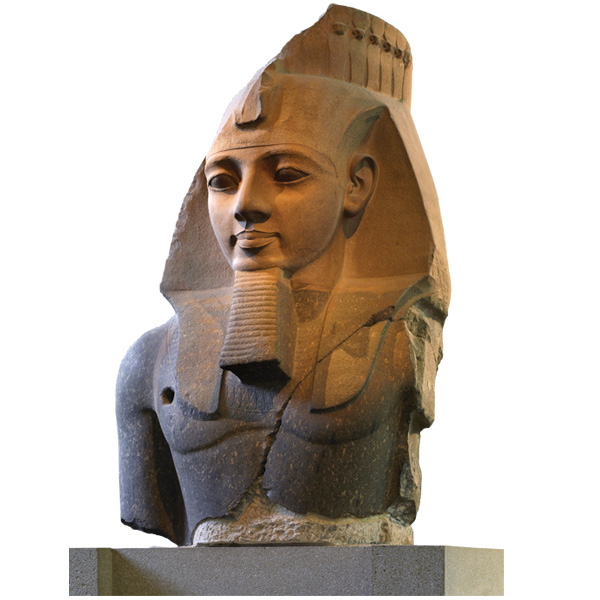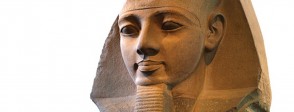
A statement of royal power
Statues like this were set up by Egypt’s kings as public statements of their divine status and power. Their massive size was meant to fill everyone who saw them with awe. They did not show the pharaoh as he really was, but perfect, like a god. For example, we know that Ramesses lived to be 92, but all his statues, including this one, show him as young, handsome and athletic, because this was how the ideal king was supposed to look.
The statue was carved out of granite from the royal quarries at Aswan, in the far south of Egypt, and had to be taken by river to the temple site. Only the king was allowed to use this stone, which, as well as being very beautiful, is extremely hard, heavy and durable. These qualities make granite ideal for a sculpture intended to last forever, but also mean it is difficult to carve and transport. Granite sculptures were therefore an important statement of the king’s wealth and power. To enhance their impact, many royal statues were painted, and some were even inlaid with precious metals and stones.
Kingship in Egypt
The institution of kingship in Egypt dates from around 3100 BC, when the ‘two lands’ of Upper and Lower Egypt – the Nile Valley and the Nile Delta – were first united under a single ruler. This act of unification was seen as establishing divine order, personified as a goddess, Maat. It was the king’s responsibility to maintain this perfect balance, making sure that the sun continued to rise and set each day, and that the Nile would flood each year to provide the fertile land needed to grow food. It was up to him to ensure that order and justice prevailed in society, and that Egypt was properly governed and protected from its enemies.
As a sign of this duty, every new king was crowned separately with the Red Crown of Lower Egypt and the White Crown of Upper Egypt before receiving the Double Crown of the Two Lands and the titles The Dual King and Lord of the Two Lands. This crown is now missing from the statue, but the base, with its circlet of protecting cobras, can be seen above Ramesses’ royal headcloth.
Kings were often shown holding a crook and flail, symbols of animal herding and agriculture – a crook was used by a shepherd, a flail to separate grain from its husks. These also were the attributes of the god Osiris, Egypt’s first king, and showed the pharaoh’s dominion over the country and its people.
The king could only fulfil his role with the help of the gods, and to win their support he built temples all over Egypt, enriching them with costly statues and lavish offerings. Temple buildings were always symmetrical to enshrine divine order; even the hieroglyphs used in the inscriptions on their walls could be written left to right or right to left to preserve the sacred balance.
Royal propaganda
Every temple was covered with scenes of gods and goddesses receiving offerings from the king and showing their approval in return. The king is usually represented on the same scale as the gods to show his divine status – ordinary people were shown much smaller. On the front of the temple, where everyone would see it, was a huge image of the king defeating Egypt’s foes.
All pharaohs tried to prove they were the rightful heir to the throne. To achieve this, they carved lists of former kings’ names in their temples to create the impression of a long line of ancestors going back to the first rulers. The royal names were written inside oval frames, called cartouches, which represented eternity.
Although these king lists look like historical documents, they are really just pieces of royal propaganda. Rulers who did not match the ideal of kingship were simply left out. Among them were those with unorthodox religious ideas, like Akhenaten and his son Tutankhamun, and female pharaohs such as Hatshepsut. Although many of these rulers had long and successful reigns, they were seen as having violated Maat by challenging established conventions, and their memories were suppressed by later kings who wanted to show they were re-establishing divine order.
More information
More information about the statue of Ramesses II
http://www.britishmuseum.org/explore/highlights/highlight_objects/aes/c/colossal_bust_of_ramesses_ii.aspx
A History of the World in 100 objects from the BBC: the bust of Ramesses II
Listen to the programme or read the transcript.
http://www.bbc.co.uk/ahistoryoftheworld/objects/JYYDgb09RdeymolMiKpNgg
Base of Ramesses’ statue in situ at the Ramesseum
http://commons.wikimedia.org/wiki/Category:Ramesseum#mediaviewer/File:Ramesseum_23.JPG
Seti I showing the young Ramesses a king list at Abydos
http://commons.wikimedia.org/wiki/Category:Reliefs_of_Ramses_II#mediaviewer/File:Abydos_Koenigsliste_Sethos_Ramses.jpg
Summary of the institution of kingship in Egypt
http://www.touregypt.net/featurestories/pharaohs.htm
Useful article on royal crowns and regalia
http://www.touregypt.net/featurestories/reg.htm
The reign of Ramesses II
http://www.bbc.co.uk/history/ancient/egyptians/ramesses_01.shtml
The reign of Queen Hatshepsut
An account of the reign of Queen Hatshepsut and the subsequent efforts to destroy her memory.
http://www.bbc.co.uk/history/ancient/egyptians/hatshepsut_01.shtml
The reign of Akhenaten
http://www.bbc.co.uk/history/historic_figures/akhenaten.shtml
The reign and legacy of Tutankhamun
http://www.bbc.co.uk/history/historic_figures/tutankhamun.shtml
More information
-
More information about the statue of Ramesses II
Source: britishmuseum.org
-
A History of the World in 100 objects from the BBC: the bust of Ramesses II
Listen to the programme or read the transcript.
Source: bbc.co.uk
-
Base of Ramesses’ statue in situ at the Ramesseum
Source: wikimedia.org
-
Seti I showing the young Ramesses a king list at Abydos
Source: wikimedia.org
-
Summary of the institution of kingship in Egypt
Source: touregypt.net
-
Useful article on royal crowns and regalia
Source: touregypt.net
-
The reign of Ramesses II
Source: bbc.co.uk
-
The reign of Queen Hatshepsut
An account of the reign of Queen Hatshepsut and the subsequent efforts to destroy her memory.
Source: bbc.co.uk
-
The reign of Akhenaten
Source: bbc.co.uk
-
The reign and legacy of Tutankhamun
Source: bbc.co.uk


